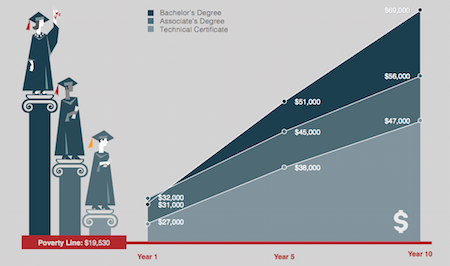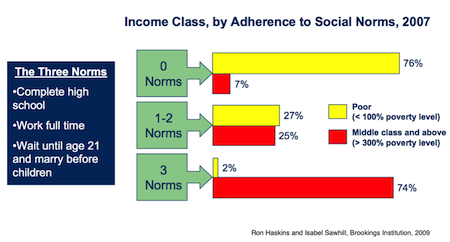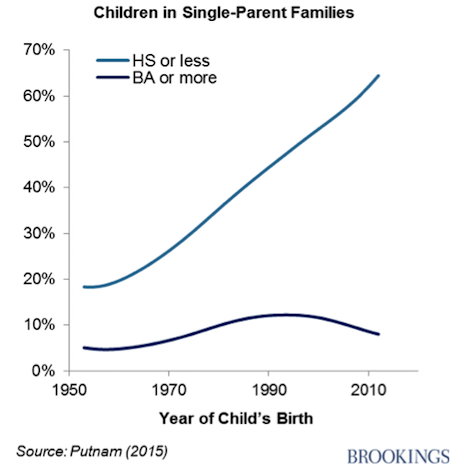Nobody knows how this year’s wild presidential campaign is going to end. But one thing’s for sure: It has exposed some fundamental rifts in American society that won’t easily be resolved.
Donald Trump’s and Bernie Sanders’ populist messages have struck a chord, particularly with working-class voters. That doesn’t surprise scholars and intellectuals on the Right and Left, who have studied these issues for years and sounded the alarm about rising inequality in wages and lifestyle.
As Charles Murray put it in the Wall Street Journal, “During the past half-century of economic growth, virtually none of the benefits have gone to the working class.” Furthermore, “for someone living in a town where the big company has shut the factory and moved the jobs to China, or for a roofer who has watched a contractor hire illegal immigrants because they are cheaper, anger and frustration are rational.”
State and national leaders have warned since at least the 1980s against leaving people behind. Southern governors particularly—think Bill Clinton and Lamar Alexander, Dick Riley and George W. Bush—understood what globalization and the changing economy meant for their citizens, and they grasped the imperative of getting many more of their workers ready for high-skill jobs. Then-Governor Alexander said in 1986, “What has suddenly riveted everyone’s attention on our education system is that our standard of living is threatened….We’re not going to have the jobs and the good incomes in America if we don’t have the good skills.” That was thirty years ago.
And to be sure, there have been lots of school reform efforts over the years—most well-meaning, and some even effective, like raising standards, publishing test results, creating charter schools, and offering vouchers for poor kids to attend private schools. But it hasn’t been nearly enough. While NAEP scores have risen at the fourth- and eighth-grade levels, they remain stubbornly flat at the end of high school. Fewer than 40 percent of our graduates leave school ready for college—not just four-year universities, but community colleges too. The numbers are much, much worse for kids growing up poor and working-class. We saw the need to equip a vastly larger number of people with stronger skills, and we didn’t get the job done.
So here we are, with low-income and working-class voters getting hammered and falling further behind their college-educated neighbors. Now they’re letting their anger be heard.
But there’s a silver lining: The political system, regardless of its dysfunction, is starting to respond. In part because of the Trump phenomenon, the challenges faced by the working class have finally captured the attention of key thinkers within the conservative coalition. Intellectuals such as David Frum and Reihan Salam, and political leaders including Speaker Paul Ryan, are calling for specific policies to help working Americans. To date, those policies have been anathema to conservative dogma and the Republican donor class. “Reform conservatives” in particular are showing an openness to new ideas, such as an expanded Earned Income Tax Credit, child tax credits, and more comprehensive wage supports.
But is that all we can do? Yes, we should ease the burden of poorer Americans by buttressing their incomes. But we must not accept that poor and working-class children will also be confined to low-skill, low-wage work. That would be tantamount to giving up on the American Dream. Instead, we should do all we can to make sure that the next generation develops the skills they need to compete for the middle-class and high-wage jobs that our economy can still produce. Our generation of reformers must succeed where the previous generation fell short.
Our schools can’t do it all, or all by themselves, but there’s still plenty of low-hanging fruit that most schools have yet to pluck—tested strategies that can help low-income and working-class kids and spur upward mobility nationwide. Let’s take a look at three of them.
1. Technical Education as a Path to the Middle Class
There’s a good reason why education reformers have become obsessed with getting many more low-income students “to and through” four-year college degrees: They are the closest things we have to a guarantee of propelling poor kids into the middle class.

But as Andrew Kelly of the American Enterprise Institute has argued, while a college degree has a big payoff, it also comes with a low probability. Among children from the bottom third of the income distribution, Kelly estimates, just 14 percent will complete four-year degrees. Even if we could double that proportion, there would still be a large majority of poor and working class kids needing another path to the middle class.
Thankfully, there is such a route: High-quality career and technical education, culminating in industry-recognized post-secondary credentials. But we’re going to need to rethink our approach to high school if we want many more students to be able to take this promising path.
Right now, we mostly shuffle kids through so-called college preparation courses. According to the most recent data, 81 percent of high school students are taking an academic route; only 19 percent are “concentrating” in CTE (which means earning at least three credits in a single CTE program area).
It’s not working. About 20 percent of teenagers don’t graduate from high school at all, including 28 percent of economically disadvantaged students. Of those who do graduate, about two-thirds matriculate to some form of college, including about half of low-income students. But a majority of students entering community colleges—and 20 percent of those going into four-year colleges—land in remedial (“development”) education because they are not academically prepared for college. Two-thirds of low-income students at community colleges start in remedial classes that earn them no degree credit.
Here’s where things really fall apart: Almost two-thirds of community college students who start in remedial courses won’t complete a credential within six years; 40 percent don’t ever get beyond the remedial stage. It’s not hard to understand why. Our K–12 system, especially the high school level, is simply not getting most of these students ready for success.
All too often, then, the outcome of our current strategy—what you might call “bachelor’s degree or bust”—is that a young person drops out of college at age twenty with no post-secondary credential, no skills, and no work experience, but a fair amount of debt. That’s a terrible way to begin adult life, and it’s even worse if the young adult aims to escape poverty.
A better approach for many young people would be to develop coherent pathways, beginning in high school, into authentic technical education options at the post-secondary level. Such efforts show great promise in better engaging students, helping them succeed academically, boosting their college-going and college completion rates, and brightening their career prospects. These arrangements not only provide access to workplaces where students can apply their skills, they also offer seamless transitions into post-secondary education, apprenticeships, and employer-provided learning opportunities. By age twenty, graduates of such programs have academic credentials, technical credentials, and work experience—and, usually, well-paying jobs.

To make this option a reality, however, local communities and education leaders will have to overcome the painful legacy of tracking. It simply doesn’t work to wait until kids are eighteen for them to choose an academic path that leads to four-year college or a technical path that leads to an associate’s degree, certification, or license. Generic high school experiences are not preparing low-income students to thrive in either academic or technical routes after they receive their diplomas. The system shouldn’t choose a student’s path—but there should be a choice.
2. Remember the Strivers
The last few years have brought long-overdue attention to the needs of high-achieving, low-income students, as well as new initiatives to ensure that they have opportunities to take rigorous coursework in high school and apply to selective colleges upon graduation.
But as welcome and important as these are, they must be complemented by efforts to help high-potential, low-income students much earlier in their academic careers.
As Tom Loveless of the Brookings Institution argues, affluent high-achievers who come into school with so many advantages typically enjoy opportunities that prepare them well for college: gifted-and-talented programs, accelerated courses, and classes with high-achieving peers. Low-income high-achievers, on the other hand, are often denied these opportunities. Their urban school systems don’t offer (or greatly restrict) gifted-and-talented programs; they mandate “heterogeneous” groupings of students and tell teachers to do their best meeting a panoply of diverse needs using “differentiated instruction.” Out of fealty to the principle of equity, they don’t let high-achievers move faster than their peers. This even though an advanced academic track would help to reduce inequalities in opportunity between rich and poor (and suburban and urban) students with great academic promise.
Partly as a result of federal pressure, many large urban districts have also embraced the idea that they should slash student suspensions and expulsions, on the grounds that doing so will interrupt the “school-to-prison pipeline.” The impulse is understandable, but if it results in more disruption in urban schools (an all-too-likely consequence), well-behaved and academically striving low-income students will lose out yet again. Who is looking out for their interests?
As Loveless argues, these issues tend to come to a head in middle school. If traditional public schools refuse to provide a safe, orderly, academically enriching environment for young adolescents to prepare for college preparatory high schools or high-quality career and technical options, then we should encourage the development of charter schools, magnet schools, and other choice strategies that do. By focusing all of our energy on the toughest cases—the very poorest kids, in the most difficult circumstances—we risk overlooking the needs of their low-income peers with the best shot at making it. That needs to change.
3. Teach the “Success Sequence”
Several years ago, Isabel Sawhill and Ron Haskins of the Brookings Institution made a startling discovery: Even young people with just a high school diploma can make it into the middle class if they work full-time and delay parenthood until they are at least twenty-one and married. Ninety-eight percent of the people who followed those norms aren’t poor; the vast majority are in the middle class. They termed these three steps—graduate high school, work full-time, and delay parenthood until marriage—the “success sequence.”

It raises the question: Is there anything schools could do to promote the success sequence, and especially the last component—delaying parenting until marriage, or at least until young people are ready for the challenges of starting a family?
It’s not hard to understand why this is such a critical issue. It’s tough enough to gain the academic and related skills to be ready for a four-year college or high-quality technical training. Add a baby and the odds can become insurmountable. You try finishing school, working a low-wage job, and caring for an infant or a toddler all by yourself. It’s no surprise, then, that only 40 percent of teen mothers finish high school, and fewer than 2 percent finish college by age thirty.
But as the working class has gotten beaten up economically, its families have fallen apart too. Single-parent families went from just under 20 percent of the working class in the 1950s to over 60 percent by the 2010s.

So what can schools do? Beyond making sure that their charges receive effective instruction about birth control, they can help teenagers develop strong prospects for interesting, decently paid careers (a good motivation for delaying parenthood). We’ve already discussed the role that well-designed technical education programs can play in getting young people ready for post-secondary education and work. Such education also appears to have a positive impact on the success sequence itself. A sophisticated evaluation by MDRC found that young men who had graduated from a career academy were 33 percent more likely to be married and living with their spouses than selected peers in a control group. They were also significantly likelier to have custody of their children.
Schools can also help their students develop the character skills needed to think long-term and stay out of trouble. The time-honored way to do this is with religion. A 2012 study by David Figlio and Jens Ludwig found that Catholic high school students were less likely to participate in risky behaviors, including teen sexual activity. They speculated that Catholic schools put the fear of God into their students. Religious instruction, they reported, “could affect students’ ‘tastes’ for misbehavior, or increase the perceived costs of misbehavior by defining a number of activities as sins that have eternal consequences.” And there was also the role of positive peer pressure—by “exposing them to more pro-social peer groups,” particularly by selecting out or expelling students more likely to engage in risky behaviors.
A newer and explicitly secular approach to teaching character is best illustrated by KIPP, which has placed character education at the heart of its “no-excuses” ethos. As made famous by Paul Tough’s best-selling book How Children Succeed, many KIPP schools now use a “character growth card” to help teachers, students, and parents work together to develop specific character traits like optimism and curiosity. Some KIPP schools are incorporating “mindfulness training” and even yoga to help their students build the self- control necessary to make better choices and build their long-term success.
There’s another way that schools can help students develop important character strengths and avoid pregnancy: provide an excellent suite of extracurricular offerings. This might be one secret to Catholic schools’ success; in their 2012 paper, Figlio and Ludwig report that students in Catholic schools “spend more time on homework and extracurricular activities than those in public schools….Private schools may thus reduce delinquency if only because of an ‘incapacitation effect’—teens who are doing homework or running track are not out looking for trouble.”
Extracurricular activities, including athletics, appear to be important for public school students too. As June Kronholz reported in Education Next, studies have long found that disadvantaged students who participate in such activities are less likely to drop out, use tobacco or alcohol, or get pregnant; they are also more likely to score well on tests, enroll in college, and complete college.
Conclusion
While our education system alone cannot solve the stubborn, tragic problem of persistent poverty and the growing gaps between working-class and college-educated Americans, there’s much it can do for the children entrusted to it. But first we have to change the way we think about the problem and its possible solutions.
Poor and working-class voters are right to be angry. Our leaders saw globalization coming and understood that it would upend our economy. But we failed to provide opportunities for all Americans to build their skills and compete for well-paying jobs. Let’s not do the same to their children.
This essay is drawn from Mike’s new edited volume, Education for Upward Mobility, which was released this week.
This was originally posted on the Fordham Institute’s Flypaper.



